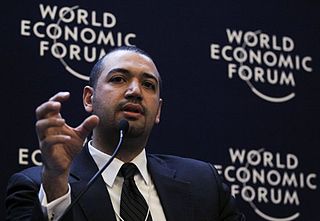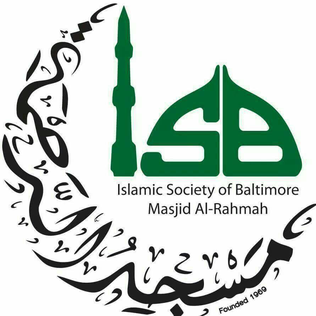
Warith Deen Mohammed, also known as W. Deen Mohammed, Imam W. Deen Muhammad and Imam Warith Deen, was an African-American Muslim leader, theologian, philosopher, Muslim revivalist, and Islamic thinker.
The Muslim American Society (MAS) is a nonprofit organization founded in 1993 and headquartered in Washington, D.C. MAS describes itself as a grassroots Islamic movement. It has more than 50 chapters across the United States.

The Night of Power, is, in Islamic belief, the night when Muslims believe the Quran was first sent down from heaven to the world and also the night when the first verses of the Quran were revealed to the Islamic prophet Muhammad; it is described as better than a thousand months of worshipping. According to various hadiths, its exact date is uncertain but it was one of the odd-numbered nights of the last ten days of Ramadan, the ninth month of the Islamic calendar. Since that time, Muslims have regarded the last ten nights of Ramadan as being especially blessed. Muslims believe that the Night of Qadr comes again every year, with blessings and mercy of God in abundance.

Chicago Lawn is one of the 77 community areas of Chicago, Illinois. It is located on the southwest side of the city. Its community neighbors include Gage Park, West Englewood, Ashburn, and West Lawn. It is bounded by Bell Avenue on the east, Central Park Avenue on the west, 59th Street on the north, and 75th Street on the south, and is 13 km (8.1 mi) southwest of the Loop. Local citizens refer to the area as "Marquette Park," after the park in its center.

Islam in Colombia is a minority religion, with most Colombians adhering to Christianity (Catholicism). According to a 2018 study conducted by Pew Research Center, the size of the Colombian Muslim population ranges from about 85,000–100,000 people out of a total population of 50.4 million. However, according to official estimates the Colombian Muslim community numbered just 10,000 people or 0.02% of the total Colombian population. Most Colombian Muslims are immigrants from the Arab World along with a small number of local converts.

Chile is a predominantly Christian country, with adherents of Islam being a minuscule minority. Due to the secular nature of Chile's constitution, Muslims are free to proselytize and build places of worship in the country. The statistics for Islam in Chile estimate a total Muslim population of approximately 5,000, representing less than 0.02% of the population. There are a number of Islamic organizations in Chile, including the Muslim Society of Chile and As-Salam Mosque in Santiago, Bilal Mosque in Iquique, the Mohammed VI Cultural Center in Coquimbo, and Islamic Foundation of Chile in Santiago.

According to 2007 statistics released by the United States Department of State concerning Islam in Nicaragua, there are approximately 1,200 to 1,500 Muslims, mostly Sunnis who are resident aliens or naturalized citizens from Palestine, Libya, and Iran or natural-born Nicaraguan citizens born to both of the two groups. The Islamic Cultural Center in Managua serves as the primary salaat (prayer) center for Muslims in the city, with approximately 320 men attending on a regular basis. Muslims from Granada, Masaya, Leon, and Chinandega also travel to the Managua center for Friday prayers. Granada, Masaya, and Leon have smaller prayer centers in the homes of prominent local Muslims. In May 2007 the Sunni leader of the Managua prayer center was dismissed, due to the increase in Iranian influence in the Muslim community and was to be replaced by a Shi'a religious leader. By the end of the reporting period the Shi'a leader had not been identified.

Sayyid Hassan al-Musawi al-Qazwini is an Iraqi-American Shia Imam.

Abd Al Aziz Awda, also known as Sheik Awda, is a Palestinian cleric who, along with Fathi Shaqaqi, founded the Islamic Jihad Movement in Palestine, also known as the Palestinian Islamic Jihad (PIJ), an Islamist paramilitary organization based in Damascus, Syria.

Universal School is an Islamic, religious, K-12 private school, that is located in Bridgeview, Illinois, in the Chicago metropolitan area. Students take Islamic Studies, Arabic language, and Quran classes. The school motto is "Where Islam and Education come together." Universal School was officially founded in 1989, and opened on September 4, 1990, to 140 students and 11 faculty members.

Dar Al-Hijrah Islamic Center is a mosque in Northern Virginia. It is located in the Seven Corners area of unincorporated Fairfax County, Virginia, in the Washington, D.C., metropolitan area.

Moez Masoud is an Egyptian scholar, public intellectual and international producer who focuses on the fields of existential questions, challenges to global co-existence, and identity in the modern world.
The American Society of Muslims was a predominantly African-American association of Muslims which was the direct descendant of the original Nation of Islam. It was created by Warith Deen Mohammed after he assumed leadership of the Nation of Islam upon the death of his father Elijah Muhammad. Warith Deen Mohammed changed the name of the Nation of Islam to the "World Community of Islam in the West" in 1976, then the "American Muslim Mission" in 1981, and finally the "American Society of Muslims" in 1988.

Hassan Ahmed Abdel Rahman Muhammed al-Banna, known as Hassan al-Banna, was an Egyptian schoolteacher and imam, best known for founding the Muslim Brotherhood, one of the largest and most influential Islamic revivalist organizations.
Mohammed Adam El-Sheikh was the Sudanese American executive director of the Fiqh Council of North America.

The city of Chicago, Illinois, is tied with St. Louis for largest Bosnian-American population and the largest number of Bosnians outside of Europe, The largest concentration of Bosnians in Chicago live on the North Side.

The Islamic Society of Baltimore (ISB) is a Muslim community center located in Catonsville, Baltimore County, Maryland, consisting of Masjid Al-Rahmah, Al-Rahmah School, and several other services. The society was founded in 1969 by three Muslim physicians and is known for then-President Barack Obama's visit on February 3, 2016. As of 2019, the society serves around 3,000 people.
There is a significant population of American Muslims in the Dallas–Fort Worth metroplex. Dallas-Fort Worth is home to sixty-two Sunni mosques. According to AbdelRahman Murphy, a Chicago-born, Irving-based Islamic teacher and Muslim community leader, other U.S.-based Muslims now refer to Dallas as the "Medina of America". Not only is Dallas Masjid Al Islam the oldest Muslim community in the DFW area, it established the first mosque in the city of Dallas and established the first Muslim school in the DFW area. As of 2021, many major Muslim organizations and charities have headquarters or operations in DFW, mostly located in Richardson, Texas such as: ICNA Dallas, Muslim American Society, Muslim Legal Fund of America, Helping Hands for Relief & Development, Sabrina Memorial Foundation, Islamic Relief USA, CAIR-Texas, and MA’RUF. There are also several institutions of research and higher education such as: Qalam Institute (Carrollton), ISRA Foundation (Plano), Bayyina Academy (Euless), and The Islamic Seminary of America (Richardson). -

Islam is the third most widely professed religion in New York City, after Christianity and Judaism. A 2018 study estimated that there are over 750,000 Muslims living in New York City, the largest population of Muslims by city in the United States. Approximately 9% of New York City residents are Muslim, constituting 22.3% of American Muslims, with 1.5 million Muslims in the greater New York metropolitan area, representing the largest metropolitan Muslim population in the Americas.—and the most ethnically diverse Muslim population of any city in the world.














